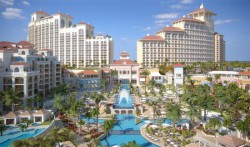EDAW, the U.S-based design firm behind the Bay Street redevelopment plan, is expected to submit a report to the government by the end of October addressing transportation issues in the capital.
Officials say the study is essential to the multimillion-dollar project moving ahead.
“You have to plan first and it has to take into account everyone’s thoughts and ideas and it has to be based on expertise,” said Malcolm Martini, national planning coordinator in the Office of the Prime Minister.
“There are certain things that would have to be decided upon and those range from the relocation of the port, which is both a private and public sector decision, as well as the location of the new port.
“But until we have all the reports in to absolutely confirm that this will not cause any environmental difficulties, we cannot move on that. So we must go through certain elements of this to make sure the plan would work and the same thing goes for transportation. If you are going to have major activities downtown, you have to make sure that the transportation system – whether public or private – will work.”
Charles Klonaris, chairman of the Nassau Tourism Development Board (NTDB), told The Bahama Journal on Wednesday that his group along with members of the government-appointed Nassau Economic Development Commission (NEDC) felt EDAW’S initial transportation plan was “inadequate” when it came to solving the problem for the entire island.
Instead, he said EDAW was asked to create a more comprehensive transportation plan.
Some Bay Street merchants have complained about the length of time it is taking for the government to begin the much talked about redevelopment and renewal of the city of Nassau.
Other storeowners have been more patient, stressing that a project of this magnitude takes time to get off the ground.
Mr. Klonaris agreed, adding that a lot is taking place to ensure that the main shopping area does not deteriorate any further.
He said part of that minor facelift includes ongoing sidewalk cleaning and placing potted plants and benches in the area – an initiative officials said is costly.
“There are so many elements to this that right now I really cannot give an answer regarding how these things will be paid [for],” Mr. Klonaris admitted.
“A lot of these depend on how the government and everyone involved goes forward with this.”
According to Frank Comito, NTDB executive director, and executive vice President of the Bahamas Hotel Association, an estimated $100,000 has already been raised from downtown merchants and key stakeholders for the project.
NTDB executives said the Ministry of Tourism is also a big supporter of the plan.
“They understand the importance of this,” Mr. Klonaris said.
“You cannot have a first class resort over Paradise Island or the new development that is scheduled to take place on Cable Beach with a city that is not really up to the standard that we would like. It just doesn’t go together.”
But while Mr. Klonaris also said it is difficult to say when the big plans will take shape, he has pointed out that once the freight terminals have been removed from the downtown area, Bahamians will see real changes.
“The government is just as anxious as we are to get started, but it’s hard to just start different pieces. We are looking at both short-term and long-term plans for the city,” he said.
“But until we get an answer from government in terms of how to proceed and who has the authority to implement the necessary changes, our hands are tied.”
According to Mr. Martini, the port relocation study and the downtown master plan have been budgeted to cost between $700,000 to $800,000.
An initial estimate puts the total cost of the redevelopment plan at $60 million.
Officials are however hoping the port is financed by the private sector.
By: Macushla N. Pinder, The Bahama Journal



